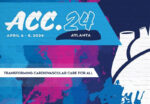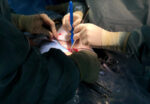Drug-coated balloons (DCB) have proven to be effective in the treatment of femoropopliteal pathology, although they entail complications such as recoil, residual stenosis, and dissection. Their outcomes could be improved through proper and enhanced vessel preparation, both before and after the procedure. Intravascular ultrasound (IVUS) offers the advantage of characterizing plaque and assessing vessel diameter....
ACC 2024 | REDUCE AMI: Beta-Blockers after Myocardial Infarction and Preserved Ejection Fraction
Most clinical trials have shown benefits of beta blockers after acute myocardial infraction, including patients with extensive AMI, and these were carried out in the era before AMI was diagnosed with biomarkers and prior to treatment with coronary angioplasty, use of antithrombotic agents and high intensity statins, and angiotensin-aldosterone system inhibitors. The aim of this...
Lithotripsy in the “Real World”: REPLICA EPIC-18 Study
Severe persistent calcification of the coronary arteries has been associated with different factors, such as advanced age, hypertension, dyslipidemia, smoking, and kidney failure, among others, and continues to be one of the challenges to stent implantation because of it impact on device advancing, drug release and adequate positioning. Intravascular lithotripsy (IVL) is a technique that...
Should We Use Ultrasound Routinely to Guide Transfemoral Access?
Currently, transfemoral access (TFA) is used in large-caliber procedures and when transradial access fails. The introduction of ultrasound (US) to guide access has emerged as a technique that allows for precise channeling, avoiding accesses above or below the inguinal ligament. However, evidence regarding the use of this tool has shown diverse results. Two surveys conducted...
Recurrent Revascularization at 10 Years after Percutaneous Treatment of DES In-Stent Restenosis
In stent restenosis (ISR) continues to be the main limitation to the percutaneous treatment of coronary artery disease, with 5 to 10% prevalence after new generation DES stenting. Guideline recommendations for this intervention include new DES stenting and the use of drug coated balloons (DCB). Recurrent ISR stenting rate ranges between 10 and 40%, and...
PCI Evolution in Infiltrative Diseases
Infiltrative diseases (ID) consist of a heterogeneous series of genetic conditions that cause infiltration and extracellular deposits which alter the diverse systems and organs affected. Amyloidosis, sarcoidosis and hemochromatosis affect the heart, altering the myocardium and the conduction system. PCI is often used at present to treat heart disease, and some of these patients present...
Events According to Revascularization Modality in the ISCHEMIA Trial
The main studies carried out on patients with chronic coronary syndromes (CCS), such as the MASS II, COURAGE, BARI 2D and FAME-2, failed to show benefits in terms of mortality with the invasive approach. The ISCHEMIA, a large randomized study including patients with moderate to severe ischemia, with without left main disease and with acceptable...
Use of Intravascular Lithotripsy vs. Rotational Atherectomy for Severely Calcified Coronary Lesions
Severely calcified coronary stenosis poses a significant challenge for coronary angioplasty procedures. Modifying plaque before stenting is crucial to a successful intervention, since it will prevent the sub expansion associated to worse clinical outcomes at followup. The tools employed to assess complex lesions include specialized balloons such as cutting, scoring, or high pressure balloons, as...
LIFE-BTK | Critical Limb Ischemia: Use of Bioresorbable Scaffold in Infrapatellar Lesions (LIFE-BTK)
Advanced stages of peripheral artery disease cause significant limitations in patients, such as critical limb ischemia (CLI), which manifests with resting pain and gangrene or ulcers of difficult resolution. Uncontrolled progression of this pathology might lead to major amputation, reduced life expectancy and increased healthcare costs. Prior research on infrapopliteal territory have shown contradicting results....
Long-term Results of Coronary Bifurcation Lesion Treatment in Diabetic Patients
The effects of diabetes on patients with coronary artery disease are well-known, and their outcomes after angioplasty are less favorable, with a higher rate of restenosis, recurrent acute myocardial infarction, and stent thrombosis. Despite advances in drug-eluting stents and procedural techniques, the treatment of coronary bifurcation lesions in diabetic patients shows less positive clinical outcomes...








